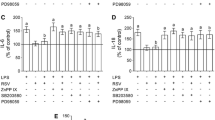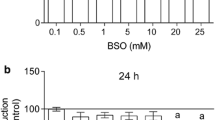Abstract
Resveratrol (3,5,4′-trihydroxy-trans-stilbene) is a polyphenol present in grapes and red wine, which has antioxidant properties and a wide range of other biological effects. In this study, we investigated the effect of resveratrol, in a concentration range of 10–250 μM, on primary cortical astrocytes; evaluating cell morphology, parameters of glutamate metabolism such as glutamate uptake, glutamine synthetase activity and glutathione total content, and S100B secretion. Astrocyte cultures were prepared of cerebral cortex from neonate Wistar rats. Morphology was evaluated by phase-contrast microscopy and immunocytochemistry for glial fibrillary acidic protein (GFAP). Glutamate uptake was measured using l-[2,3-3H]glutamate. Glutamine synthetase and content of glutathione were measured by enzymatic colorimetric assays. S100B content was determined by ELISA. Typical polygonal morphology becomes stellated when astrocyte cultures were exposed to 250 μM resveratrol for 24 h. At concentration of 25 μM, resveratrol was able to increase glutamate uptake and glutathione content. Conversely, at 250 μM, resveratrol decreased glutamate uptake. Unexpectedly, resveratrol at this high concentration increased glutamine synthetase activity. Extracellular S100B increased from 50 μM upwards. Our findings reinforce the protective role of this compound in some brain disorders, particularly those involving glutamate toxicity. However, the underlying mechanisms of these changes are not clear at the moment and it is necessary caution with its administration because elevated levels of this compound could contribute to aggravate these conditions.





Similar content being viewed by others
References
Allen S, Shea JM, Felmet T, Gadra J, Dehn P (2001) A kinetic microassay for glutathione in cells plated on 96-well microtiter plates. Methods Cell Sci 22:305–312
Bak LK, Schousboe A, Waagepetersen HS (2006) The glutamate/GABA-glutamine cycle: aspects of transport, neurotransmitter homeostasis and ammonia transfer. J Neurochem 98:641–653
Baur JA, Sinclair DA (2006) Therapeutic potential of resveratrol: the in vivo evidence. Nat Rev Drug Discov 5:493–506
Castagne V, Gautschi M, Lefevre K, Posada A, Clarke PG (1999) Relationship between neuronal death and the cellular redox status. Focus on the developing nervous system. Prog Neurobiol 59:397–423
Cechin SR, Gottfried C, Prestes CC, Andrighetti L, Wofchuk ST, Rodnight R (2002) Astrocyte stellation in saline media lacking bicarbonate: possible relation to intracellular pH and tyrosine phosphorylation. Brain Res 946:12–23
Chen CJ, Liao SL, Kuo JS (2000) Gliotoxic action of glutamate on cultured astrocytes. J Neurochem 75:1557–1565
Donato R (2001) S100: a multigenic family of calcium-modulated proteins of the EF-hand type with intracellular and extracellular functional roles. Int J Biochem 33:637–668
Dore S (2005) Unique proprieties of polyphenol stilbens in the brain: more than direct antioxidant actions; gene/protein regulatory activity. Neurosignals 14:61–70
Dos Santos AQ, Nardin P, Funchal C, Vieira de Almeida LM, Jacques-Silva MC, Wofchuk ST, Gonçalves CA, Gottfried C (2006) Resveratrol increases glutamate uptake and glutamine synthetase activity in C6 glioma cells. Arch Biochem Biophys 453:161–167
Dringen R (2000) Metabolism and functions of glutathione in brain. Prog Neurobiol 62:649–671
Dringen R, Pfeiffer B, Hamprecht B (1999) Synthesis of the antioxidant glutathione in neurons: supply by astrocytes of CysGly as precursor for neuronal glutathione. J Neurosci 19:562–569
Fremont L (2000) Biological effects of resveratrol. Life Sci 66:663–673
Gao ZB, Chen XQ, Hu GY (2006) Inhibition of excitatory synaptic transmission by trans-resveratrol in rat hippocampus. Brain Res 1111:41–47
Gescher AJ, Steward WP (2003) Relationship between mechanisms, bioavailability, and preclinical chemopreventive efficacy of resveratrol: a conundrum. Cancer Epidemiol Biomarkers Prev 12:953–957
Gottfried C, Valentim L, Salbego C, Karl J, Wofchuck ST, Rodnight R (1999) Regulation of protein phosphorylation in astrocytes cultures by external calcium ions: specific effects on the phosphorylation of GFAP, vimentin and heat shock protein 27 (HSP27). Brain Res 833:142–149
Gottfried C, Tramontina F, Gonçalves D, Gonçalves CA, Moriguchi E, Dias RD, Wofchuk ST, Souza DO (2002) Glutamate uptake in cultured astrocytes depends on age: a study about the effect of guanosine and the sensitivity to oxidative stress induce by H(2)O(2). Mech Ageing Dev 123:1333–1340
Gottfried C, Cechin SR, Gonzalez MA, Vaccaro TS, Rodnight R (2003) The influence of the extracellular matrix on the morphology and intracellular pH of cultured astrocytes exposed to media lacking bicarbonate. Neuroscience 121:553–562
Guillet BA, Velly LJ, Canolle B, Masmejean FM, Nieoullon AL, Pisano P (2005) Differential regulation by protein kinases of activity and cell surface expression of glutamate transporters in neuron-enriched cultures. Neurochem Int 46:337–346
Han YS, Zheng WH, Bastianetto S, Chabot JG, Quiron R (2004) Neuroprotective effects of resveratrol against β-amyloid-induced neurotoxicity in rat hippocampal neurons: involvement of protein kinase C. Br J Pharmacol 141:997–1005
Hertz L (2006) Glutamate, a neurotransmitter–and so much more. A synopsis of Wierzba III. Neurochem Int 48:416–425
Jannin B, Menzel M, Berlot JP, Delmas D, Lanchón A, Latruffe N (2004) Transport of resveratrol, a cancer chemopreventive agent, to cellular targets: plasmatic protein binding and cell uptake. Biochem Pharmacol 68:1113–1118
Kim YA, Lim SY, Rhee SH, Park KY, Kim CH, Choi BT, Lee SJ, Park YM, Choi YH (2006) Resveratrol inhibits inducible nitric oxide synthase and cyclooxygenase-2 expression in beta-amyloid-treated C6 glioma cells. Int J Mol Med 17:1069–1075
Klinge CM, Blankenship KA, Risinger KE, Bhatnagar S, Noisin EL, Sumanasekera WK, Zhao L, Brey DM, Keyton RS (2005) Resveratrol and stradiol rapidly activate MAPK signaling through estrogen receptor α and β in endothelial cells. J Biol Chem 280:7460–7468
Leite M, Frizzo JK, Nardin P, de Almeida LM, Tramontina F, Gottfried C, Gonçalves CA (2004) Beta-hydroxy-butyrate alters the extracellular content of S100B in astrocyte cultures. Brain Res Bull 64:139–143
Leite MC, Brolese G, de Almeida LM, Pinero CC, Gottfried C, Gonçalves CA (2006) Ammonia-induced alteration in S100B secretion in astrocytes is not reverted by creatine addition. Brain Res Bull 70:179–185
Lowry OH, Rosenbrough NJ, Farr AL, Randall RJ (1951) Protein measurement with the Folin-Phenol reagents. J Biol Chem 193:265–275
Matute C, Alberdi E, Ibarretxe G, Sanchez-Gomez MV (2002) Excitotoxicity in glial cells. Eur J Pharmacol 447:239–246
Ovesna Z, Horvathova-Kozics K (2005) Structure-activity relationship of trans-resveratrol and its analogues. Neoplasma 52:450–455
Pervaiz S (2004) Chemotherapeutic potential of the chemopreventive phytoalexin resveratrol. Drug Resist 7:333–344
Petito CK, Chung MC, Verkhovsky LM, Cooper AJL (1992) Brain glutamine synthetase increases following cerebral ischemia in the rat. Brain Res 569:275–280
Signorelli P, Ghidoni R (2005) Resveratrol as an anticancer nutrient: molecular basis, open questions and promises. J Nutr Biochem 16:449–466
Stewart JR, Christman KL, O’Brian CA (2000) Effects of resveratrol on the autophosphorylation of phorbol ester-responsive protein kinases: inhibition of protein kinase D but not protein kinase C isozyme autophosphorylation. Biochem Pharmacol 60:1355–1359
Tietze F (1969) Enzymatic method for quantitative determination of nanogram amounts of total and oxidized glutathione: applications to mammalian blood and other tissues. Anal Biochem 27:502–522
Tramontina F, Karl J, Gottfried C, Mendez A, Gonçalves D, Portela LV, Gonçalves CA (2000) Digitonin-permeabilization of astrocytes in culture monitored by trypan blue exclusion and loss of S100B by ELISA. Brain Res Protoc 6:86–90
Tramontina F, Leite MC, Gonçalves D, Tramontina AC, Souza DF, Frizzo JK, Nardin P, Gottfried C, Wofchuk ST, Gonçalves CA (2006) High glutamate decreases S100B secretion by a mechanism dependent on the glutamate transporter. Neurochem Res 31:815–820
Trotti D, Danbolt NC, Volterra A (1998) Glutamate transporters are oxidant-vulnerable: a molecular link between oxidative and excitotoxic neurodegeneration? Trends Pharmacol Sci 19:328–334
Van Eldik LJ, Wainwright MS (2003) The janus face of glial-derived S100B: beneficial and detrimental functions in the brain. Restor Neurol Neurosci 21:97–108
Wang Q, Xu J, Rottinghaus GE, Simonyi A, Lubahn D, Sun GY, Sun AY (2002) Resveratrol protects against global cerebral ischemic injury in gerbils. Brain Res 958:439–447
Wang Q, Li H, Wang XW, Wu DC, Chen XY, Liu J (2003) Resveratrol promotes differentiation and induces Fas-independent apoptosis of human medulloblastoma cells. Neurosci Lett 351:83–86
Wang Q, Yu S, Simonyi A, Rottinghaus G, Sun GY, Sun AY (2004) Resveratrol protects against neurotoxicity induced by kainic acid. Neurochem Res 29:2105–2112
Acknowledgments
This work was supported by Conselho Nacional de Desenvolvimento Científico e Tecnológico (CNPq), Coordenação de Aperfeiçoamento de Pessoal de Nível Superior (CAPES) and Fundação de Amparo à Pesquisa do Estado do Rio Grande do Sul (FAPERGS). We would like to thank Ms. Alessandra Heizelmann for technical support with cell culture.
Author information
Authors and Affiliations
Corresponding author
Rights and permissions
About this article
Cite this article
Vieira de Almeida, L.M., Piñeiro, C.C., Leite, M.C. et al. Resveratrol Increases Glutamate Uptake, Glutathione Content, and S100B Secretion in Cortical Astrocyte Cultures. Cell Mol Neurobiol 27, 661–668 (2007). https://doi.org/10.1007/s10571-007-9152-2
Received:
Accepted:
Published:
Issue Date:
DOI: https://doi.org/10.1007/s10571-007-9152-2




